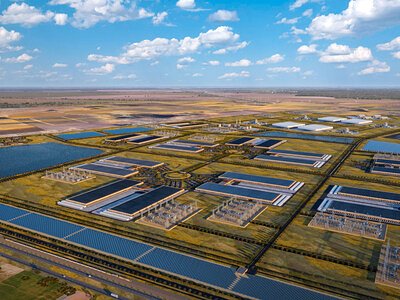
AI's Thirst: Texas Mega-Campus Tests Limits of Water & Energy Demands
A massive new energy campus in the Texas Panhandle, designed to power the next generation of AI, is sparking debate over water usage, economic benefits, and the sustainability of the booming tech sector.
AI's Thirst: Texas Mega-Campus Tests Limits of Water & Energy Demands
Amarillo, TX – In the arid landscape of the Texas Panhandle, a bold vision is taking shape: a sprawling 11-gigawatt energy campus designed to power the voracious appetite of artificial intelligence. Fermi America, backed by former U.S. Energy Secretary Rick Perry, has secured partnerships with the City of Amarillo and Carson County, promising economic growth and high-tech jobs. But the project is also raising critical questions about water sustainability, resource allocation, and the long-term impact of powering the AI revolution.
Fermi America’s ambitious plan hinges on a steady supply of energy and water – up to 2.5 million gallons per day – secured through a 20-year agreement with Amarillo. This rate is double what other users pay, a fact that has stirred controversy locally. Coupled with a 10-year tax abatement from Carson County, the deal underscores the lengths some communities are willing to go to attract the burgeoning AI industry.
The AI Energy Nexus
The demand for energy is skyrocketing as AI models become increasingly complex. Data centers, the physical infrastructure that houses AI computing, are notoriously energy-intensive. While renewable energy sources are playing an increasing role, the sheer scale of demand requires diverse and reliable power generation. Fermi America’s campus will integrate nuclear, natural gas, solar, and battery storage, aiming to provide a redundant and resilient energy supply.
“The need for dedicated power infrastructure for AI is only going to intensify,” explains an industry analyst familiar with the project. “Existing grids are often stretched thin, and AI applications require consistent, high-quality power. This is a significant investment in addressing that need.”
Water Woes in the Panhandle
However, the water component of the project is proving more contentious. The Texas Panhandle is already a semi-arid region, and water resources are under increasing strain due to population growth and agricultural demands. Providing a preferential rate to Fermi America has sparked concerns about equity and long-term sustainability.
“We understand the desire for economic development, but this deal feels like prioritizing a private company over the needs of the community,” said a local resident involved in water conservation efforts. “It’s a question of whether we’re willing to deplete a vital resource for the benefit of a few.”
Data from the Texas Water Development Board shows that groundwater levels in some areas of the Panhandle are declining. While Amarillo officials maintain that the city has sufficient water resources to meet current and future demands, critics argue that the long-term consequences of the Fermi America deal haven't been adequately assessed.
Economic Promise vs. Environmental Risk
The potential economic benefits are undeniable. Fermi America projects the creation of numerous jobs during construction and operation, and promises a significant boost to the local economy. Carson County officials are optimistic that the campus will attract other high-tech companies, further diversifying the region’s economic base.
“This project represents a transformative opportunity for our community,” stated a county economic development official. “It will create good-paying jobs, attract investment, and position us as a leader in the AI industry.”
However, the environmental costs are also significant. In addition to water consumption, the campus will generate greenhouse gas emissions from natural gas and nuclear power. While Fermi America has committed to incorporating renewable energy sources, the overall carbon footprint remains a concern.
“It’s a classic trade-off between economic growth and environmental sustainability,” explains an environmental scientist studying the project. “We need to carefully weigh the benefits against the risks and ensure that we’re not sacrificing long-term ecological health for short-term economic gains.”
A Broader Trend
The Fermi America project isn’t an isolated incident. Across the country, communities are competing to attract data centers and AI infrastructure, often offering tax incentives and preferential utility rates. This competition is raising questions about the sustainability of the AI boom and the need for a more holistic approach to resource management.
“We’re seeing a pattern of communities prioritizing economic development over environmental sustainability,” notes an energy policy analyst. “We need to develop a more sustainable model that balances economic growth with resource conservation and environmental protection.”
The situation in Amarillo highlights the challenges of powering the AI revolution in a resource-constrained world. The project’s success will depend not only on its economic viability but also on its ability to address the environmental concerns and ensure the long-term sustainability of the region’s water resources. The eyes of the tech industry – and environmental advocates – are now focused on the Texas Panhandle, watching to see if this bold experiment can deliver on its promises without depleting a vital resource.
